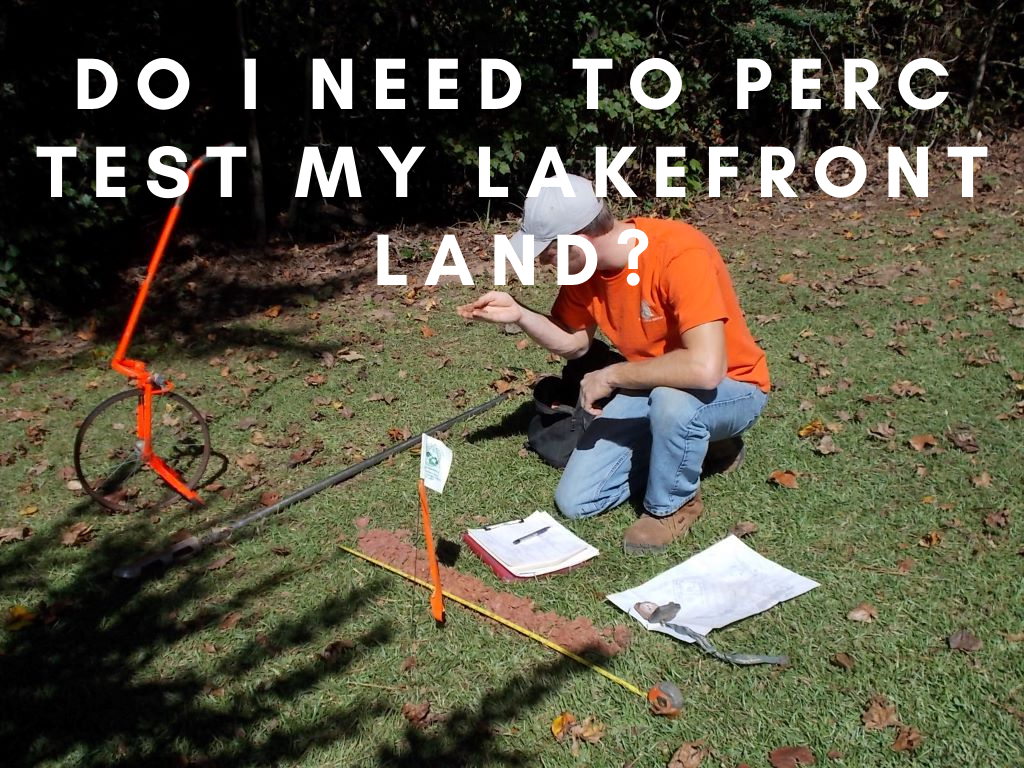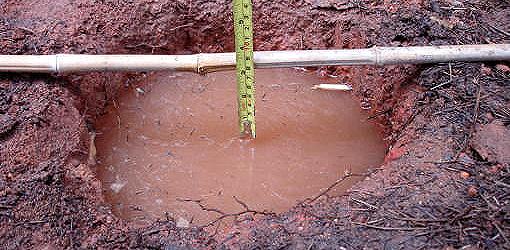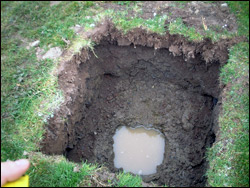
Perc testing… You’ll hear this term thrown around a lot by Real Estate Agents, but what does it really mean? The purpose of the testing is to determine if the soils on a particular lake lot are suitable for an on lot septic system. As a seller having the lot perc tested and a septic permit first prior to listing your property is a good idea.
Traditional septic systems only work if the soil in the leach field area is sufficiently permeable that it can readily absorb the liquid effluent flowing into it. Otherwise, untreated effluent may back up and pool on the ground surface.
Also, there must be at least a few feet of good soil from the bottom of the perforated leach pipes to the rock or impervious hardpan below, or to the water table. Much of the treatment takes place in this soil layer.
Less commonly, a site can fail because the soil is too permeable, allowing the effluent to reach the groundwater before it is fully treated. Very steep slopes are also unsuitable for a conventional leach field.

The specific standards vary from town to town, but any of these characteristics can prohibit the use of a standard gravity-fed septic system. In some cases, a more expensive alternative septic system may be allowed. To determine if a building site is suitable for a septic system, a percolation test (typically called a “perc test’ or “perk test”) is required.
On lake sites without municipal sewage systems, a failed perc test means that no house can be built – which is why you should make any offer to purchase land contingent on the site passing the soil and perc tests. As prime lake building sites become increasingly scarce (or prohibitively expensive) in many parts of the country, lake sites that will not pass a percolation or perc test are increasingly common.
In general, soils with high sand and gravel content drain the best and soils with a high clay content or solid rock are the worst. Most soils fall somewhere in the middle with a mix of coarse sand and gravel particles, small silt particles, and miniscule clay particles – the smallest.
How to Perc Test-
To conduct a perc test, first talk to the local health department official as requirements can vary significantly from town to town as far as who can conduct the test, the minimum number of holes, depth of holes, required absorption rates, and when the tests can be performed. In general, tests cannot be conducted in frozen or disturbed soil, and some areas only allow tests during certain months of the year when soils tend to be wetter – so plan ahead.

A typical perc test consists of two or more holes dug about 30 to 40 feet apart in the proposed drain field area. The holes are typically 6 to 12 inches in diameter and 2 to 3 feet deep, the typical depth of the absorption trenches in a leach field. Next, you or the technician should place 2 inches of clean gravel in the bottom of the hole.
Scrape the sides of the hole with a sharp tool (nails driven through the end of a 1×2 work well) to loosen soil compacted during digging, and remove any loose soil from the bottom of the hole. Since the perc test is meant to simulate the actual conditions in a working septic system, the soil is then “pre-soaked” for several hours to saturate the soil. Keep adding water to maintain about 12 inches of water in the hole for at least 4 hours. Clay soils should soak for at least 12 hours to fully saturate.
The next day, clean out any loose soil that has fallen to the bottom, and carefully fill each hole with water to a depth of 6 inches above the gravel. Then measure how much the water drops in 30 minutes (or less for highly permeable soil that drains quickly). The times are then carefully documented and used to calculate the percolation rate – the time it takes for the water to fall one inch.
The percolation rate is usually expressed in minutes per inch of drop. A rate of 60 minutes per inch (MPI), meaning the water dropped one inch in 60 minutes, is often the cutoff point for a standard gravity-flow septic system, although the maximum number varies from 30 to 120 MPI depending on local regulations. Some towns require additional “hydraulic” soil tests for sites that test above 30 minutes per inch.
The cutoff for too-fast percolation is typically 1 to 3 minutes per inch. Below that, water absorbs too fast to be effectively treated before reaching the groundwater. The worst-performing hole is the one that counts. Some towns require that a town official be present to witness the test.

Perc test regulations vary a great deal from one town to the next. General ranges for soil permeability are as follows:
- Below 5 MPI: Highly permeable soil. Alternative systems may be allowed, including pre-treatment of effluent, pressurized dosing, or addition of denser soil around trenches.
- 5 – 60 MPI: Conventional leach field permitted.
- 60 – 120 MPI: Low-permeable soil. Alternative systems may be allowed, including pre-treatment of effluent, pressurized dosing, enhanced treatment, mound systems, and other alternative systems.
- Above 120 MPI: Very low-permeable soil. Alternative systems with enhanced wastewater treatment may be allowed under some conditions.
Test results are usually good for two to five years, and in some cases can be renewed. However, with all things perc, rules vary greatly from town to town so don’t make any assumptions. Always check with the town health department before proceeding.
It is always a good idea to perc test your lakefront land before buying so you know what kind of septic situation you are getting into and what the additional steps you will need to take!
Posted by Scott Freerksen “The Lake Guy”
